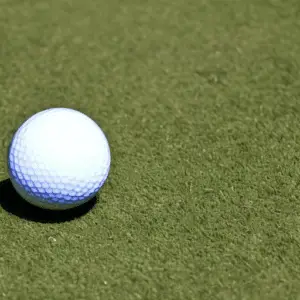Last Updated on October 12, 2023
Have you ever wondered how much golf balls weigh? It might not seem like an important factor when selecting a ball, but it’s actually more critical than most people think. Believe it or not, the weight of a golf ball can have quite an impact on your game. But just how much do golf balls weigh? We’ll be exploring this topic in depth to answer that very question. From factors that affect the weight to different types of golf balls available, we’ve got all the information needed to make sure you hit your mark.
Table of Contents:
- Weight of a Golf Ball
- Factors that Affect Weight
- Different Types of Golf Balls
- FAQs in Relation to How Much Do Golf Balls Weigh
- Conclusion
Weight of a Golf Ball
Golf balls come in a variety of sizes and weights, with the average weight being around 45.93 grams. The weight of a golf ball is an important factor to consider when playing the game, as it affects how far you can hit the ball, how well you control your shots, and even your overall score.
The size and weight of a golf ball are determined by its core material, which is usually made from rubber or plastic. A heavier core will produce more spin on the ball, while lighter cores will produce less spin but more distance off the tee box. Heavier golf balls also tend to be harder than lighter ones due to their increased density.
Factors that Affect Weight
The weight of a golf ball is an important factor in determining how far it will travel and its overall performance. The material used to make the ball, its size, and its compression are all factors that can affect the weight of a golf ball.
Material
Different materials have different weights. For example, balls made from rubber or plastic tend to be lighter than those made from metal or ceramic. The type of material used also affects the durability of the ball; some materials may last longer than others under certain conditions.
Size
Golf balls come in various sizes ranging from small (1 inch) to large (2 inches). Smaller balls tend to weigh less than larger ones due to their smaller surface area. As such, they may not fly as far when hit with a club but could be useful for putting practice on short distances or for children learning how to play golf who need more control over their shots.
Compression
Compression refers to how tightly packed together the particles inside a golf ball are compressed during the manufacturing process, which affects its weight as well as other characteristics like spin rate and flight distance when hit by a club head at impact speeds above 90 mph. Higher compression means more energy is transferred into launch speed resulting in the increased distance, while lower compression results in a softer feel off the face with fewer spin rates, making it easier for players with slower swing speeds to generate more carry distance without sacrificing accuracy.
Overall, understanding these three factors can help you choose the right type of golf ball for your game depending on your skill level and playing style preferences so that you get the maximum performance out of each shot taken out on the course.
Different Types of Golf Balls

The standard golf ball is 1.62 ounces (45 grams). This is considered the “average” weight, and most golfers will use this type of ball. It provides a good balance between distance and control when hitting shots off the tee or fairway.
There are also lighter balls available that weigh around 1 ounce (28 grams). These are often used by beginner players who don’t yet have the strength or technique to hit long drives with a heavier ball. Lighter balls provide more lift and spin, which can help beginners get their shots airborne more easily.
On the other end of the spectrum, there are heavier golf balls that weigh up to 2 ounces (56 grams). Heavier balls offer increased distance but require more power from your swing to achieve maximum performance. They also tend to be less forgiving than lighter models as they don’t spin as much when struck off-centre resulting in less accuracy overall. Professional players often prefer using these types of golf balls due to their added power potential, but they may not be suitable for recreational players looking for better control over their shots.
Finally, there are mid-weight options available that fall somewhere between 1 and 2 ounces (28 – 56 grams), depending on manufacturer specifications. Mid-weight golf balls offer a compromise between lightness and heaviness, providing enough lift for accurate short gameplay while still offering some extra distance compared with lighter models. They make an ideal choice for intermediate-level players who want both accuracy and distance from their shots without having too much difficulty controlling them.
Choosing which type of golf ball is best suited for you depends largely on your skill level, strength, and playing style. Beginners should opt for lightweight models, while experienced professionals may benefit from heavier ones if they need extra yardage off each shot. Intermediate-level players should experiment with different weights until they find what works best for them.
FAQs in Relation to How Much Do Golf Balls Weigh
How much do 12 golf balls weigh?
Golf balls typically weigh around 1.62 ounces (45.93 grams). This is the average weight of a standard golf ball, and it can vary slightly depending on the type of material used in its construction. For example, some golf balls are made with a softer core that adds more weight to them than others. The size and shape of the ball also affect its overall weight; larger balls tend to be heavier than smaller ones. Ultimately, 12 golf balls can range anywhere from 18-22 ounces (510-624 grams) depending on their make and model.
How many golf balls make a pound?
A pound of golf balls is equal to approximately 24 golf balls. This number can vary slightly depending on the size and weight of the individual golf ball, as well as any additional packaging or materials used in its production. Generally speaking, a standard-sized golf ball will weigh around 1.62 ounces (45 grams), so it takes roughly 24 of them to make up one pound. As such, if you’re looking for an exact answer when it comes to how many golf balls make a pound, then the answer is 24.
How much does a Callaway golf ball weigh?
A Callaway golf ball typically weighs around 1.620 ounces (45.93 grams). This is slightly heavier than the average golf ball, which usually weighs between 1.620 and 1.680 ounces (45.93 to 47.63 grams). The extra weight of a Callaway golf ball gives it more momentum when hit, allowing for longer drives off the tee box and increased accuracy on approach shots into the green. Additionally, its higher density provides a softer feel that many players prefer when putting or chipping around the green.
Conclusion
Understanding how much do golf balls weigh can help you make an informed decision when selecting the best ball for your needs. With so many options available, there is sure to be a ball that fits perfectly into your golfing arsenal. Don’t let weight be the deciding factor – instead, focus on finding the right combination of spin, feel and distance that works best for you.


